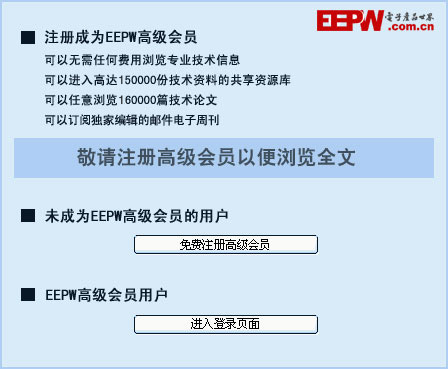限制穩(wěn)壓器啟動(dòng)時(shí)dV/dt和電容的電路
有時(shí),設(shè)計(jì)約束突出地暴露了平凡器件和電路的不利方面。這種案例有供電源穩(wěn)壓電路的設(shè)計(jì),電路中一次電源有完全限流規(guī)定,例如太空船的光電或“日光”板和放射性同位元素?zé)犭姲l(fā)生器。這種應(yīng)用需要謹(jǐn)慎嚴(yán)格的控制電流消耗,包括瞬變電流消耗和罕見消耗尖峰,例如那些上電時(shí)典型發(fā)生的。問題是限流一次電源即使響應(yīng)瞬間的過流故障,都會(huì)損害災(zāi)難性的電壓降并關(guān)閉。通常這種故障由穩(wěn)壓器輸出的去耦電容釋放的電流尖峰引起。
除非穩(wěn)壓器限流削弱發(fā)生的尖峰,尖峰與穩(wěn)壓器輸出電壓上升速率與并聯(lián)輸出總電容的乘積相等:IMAX=dV/dt×COUT,其中IMAX是最大電流,dV/dt為電壓對(duì)時(shí)間的微分,COUT為輸出電容。公式表明限制穩(wěn)壓器接通最大電流的最佳策略是限制dV/dt。如圖1電路基于這個(gè)方法,使用工業(yè)標(biāo)準(zhǔn)的可調(diào)線性穩(wěn)壓器,例如流行的low-dropout LM2941。

限制dV/dt方法的基礎(chǔ)包含6個(gè)額外器件:R3、R4、CT、D1、D2和Q1。上電時(shí),控制電流通過R3、CT和D2使輸出電壓上升延遲,因此阻止了過大的瞬時(shí)最大電流。
下面是其工作過程。當(dāng)VIN打開且Q1關(guān)閉時(shí),電流通過R3、CT和D2上拉穩(wěn)壓器參考端到參考電壓。這個(gè)動(dòng)作限制了VOUT 的dV/dt到CT通過串聯(lián)電阻放電的速率,(R3+R1R2/(R1+R2)),使用公式R3=(VIN–VREF–1)/VOUT,R4=20R3,和CT=COUTVOUT/(IMAX(R3+R1R2/(R1+R2))),從而限制IMAX到任何需要值。例如,假定電路如圖所示,COUT=100 μF,dV/dt=2500V/s,且IMAX=0.25A。在改進(jìn)的上電序列后部,D1和D2從穩(wěn)壓器反饋網(wǎng)絡(luò)中分離dV/dt電路,防止從輸入到輸出紋波電壓的耦合。
英文原文:
Circuit limits dV/dt and capacitor inrush at regulator turn-on
Adding a simple circuit to the adjust pin of a regulator controls the dV/dt of the output voltage, limiting inrush current.
W Stephen Woodward, Chapel Hill, NC; Edited by Charles H Small and Fran Granville -- EDN, 10/11/2007
Unusual design constraints sometimes reveal the unfriendly side of everyday components and circuits. A case in point is the design of power-supply-regulation circuitry in which the primary power source has an absolute current-limit specification, such as spacecraft photovoltaic, or “solar,” panels and radioisotope-thermoelectric generators. Such applications require that you pay scrupulous attention to strict control of current consumption, including transient-current consumption, and infrequent consumption spikes, such as those that typically occur on power-up. The problem is that current-limited primary-power sources can suffer catastrophic voltage droop and shutdown in response to momentary overcurrent faults, even when the fault is brief. Common causes of such faults are the current spikes that charge the regulator output’s decoupling capacitor.
Unless the current limit of the regulator clips the resulting spikes, the spikes are equal to the regulator’s output-voltage rate of rise multiplied by the sum of the parallel output capacitances: IMAX="dV/dt"×COUT, where IMAX is the maximum current, dV/dt is a differential in voltage with respect to a differential in time, and COUT is the output capacitance. The math suggests that the best strategy for limiting the regulator’s turn-on maximum current is to limit dV/dt. The circuit in Figure 1 relies on this trick and works with industry-standard adjustable linear regulators, such as the popular low-dropout LM2941.
The basis of the dV/dt-limiting technique comprises the six added components: R3, R4, CT, D1, D2, and Q1. On power-up, the control current through R3, CT, and D2 delays the rise of the output voltage and thus prevents excessive maximum-current transients.
Here’s how it works. When VIN is on and Q1 is off, current through R3, CT, and D2 pulls the adjust pin of the regulator to the reference. This action limits VOUT’s dV/dt to the rate of CT charging through the series resistance, (R3+R1R2/(R1+R2)), and thereby limits IMAX to any desired value using the design equations R3=(VIN–VREF–1)/VOUT, R4=20 R3, and CT="COUTVOUT/"(IMAX(R3+R1R2/(R1+R2))). For example, given the circuit constants in the figure and assuming COUT="100" μF, dV/dt=2500V/s, and IMAX="0".25A. At the end of the modified power-up sequence, D1 and D2 decouple the dV/dt circuit from the regulator’s feedback network, preventing the coupling of ripple voltages from the input voltage into the output voltage.
英文原文地址:http://www.edn.com/article/CA6486029.html
基爾霍夫電流相關(guān)文章:基爾霍夫電流定律








評(píng)論